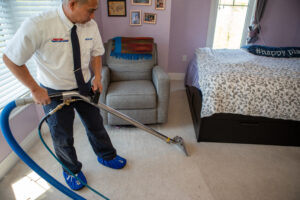If you’ve ever spilled coffee, tracked in mud, or watched a glass of red wine tip over, you know how quickly small accidents can turn into stubborn carpet stains. The reason carpet stain removal is so tricky is that each type of stain behaves differently. Therefore, one cleaning method rarely works for every spill.
For example, coffee and wine bond to carpet fibres, blood and milk harden as they dry, and grease and oil repel water, requiring a special stain removal treatment. Even the type of carpet you have (wool, synthetic, or a blend) affects how a stain sets and how you should remove it. That’s why it’s important to know what type of stain you’re dealing with, the science behind it, and how to treat it effectively from the start.
At Prestige Carpet Cleaning, we’ve spent decades removing carpet and rug stains of all types, from A to Z. As a result, we’ve built a reputation as the trusted experts who know what works, what doesn’t, and why. From emergency spill response to advanced stain removal techniques, we’ve seen firsthand how acting quickly and using the right solution is the key to eliminating tough stains. This stain removal guide distills that experience into practical, proven advice, so you know how to remove carpet stains when they happen—and when to call the pros.
What Should You Do First To Remove a Carpet Stain?
Quick Answer: Act fast, blot instead of rubbing, and always test your cleaning solution in a hidden area before treating a carpet stain.
Have a spill on your carpet or rug, and wondering what you need to do immediately to remove it? Here are the first steps you should take in any emergency spill response situation, regardless of the type of stain you’re dealing with.
- Act Fast (But Don’t Panic): The first step to treating a carpet stain is to act fast. That’s because the quicker you treat a stain, the less likely it is to set. That said, don’t panic. Take the time to understand how to properly treat the stain so you don’t cause more damage.
- Blot, Never Rub: Your next step is to gently blot the stain with a cloth (we recommend using a white cloth, towel or paper towel). It’s important to avoid rubbing the stain, as this will force it deeper into the carpet fibres.
- Test Your Carpet Cleaning Solution: Finally, before you start treating the stain, you’ll want to test your cleaning solution. Whether it’s a store-bought cleaner or a DIY carpet stain remover, be sure to test it in a hidden area (like the corner of a closet) first to avoid damage.

What Causes Carpet Stains & Why Are Some So Hard to Remove?
Quick Answer: Carpet stains form when tannins, proteins, oils and grease, or dyes and pigments chemically bond with fibres. Some dissolve in water, while others resist it, making them harder to remove.
Have you ever wondered why some spills clean up easily with a little water, while others require advanced stain removal techniques? The answer lies in the chemistry of the stain itself.
Different substances, like wine, grease, or ink, interact with carpet fibres in different ways. Some bond tightly to the fibres, others harden as they dry, and many resist water altogether. That’s why there’s no single “one-size-fits-all” carpet stain remover solution. Instead, the right cleaning method depends on understanding what caused the stain in the first place.
In general, most carpet stains fall into five main categories:
- Tannin-based stains
- Protein-based stains
- Water-soluble stains
- Oil/grease stains
- Dye/pigment stains
IMPORTANT TO NOTE: Some stains are combination stains and therefore fall under more than one category. These types of stains can be especially difficult to remove from rugs and carpets. For example, chocolate is a tough-to-remove combination stain that contains three kinds of stain-causing components: tannins (from the cocoa), oils (from the cocoa butter), and often proteins (from the added milk).
The reference table below breaks down the main types of carpet stains, explains why they occur, and categorizes everyday household spills.
*Combination stains are listed in more than one category.
The Science Behind Common Carpet Stains – Why Spills Turn Into Stains
| Stain Type | Why It Stains Carpets & Rugs | Common Examples |
| Tannin-Based | Plant compounds called tannins bind to fibres, causing discoloration. | Red wine, beer, coffee, tea, fruit juice, pop, sauces, chocolate, ketchup, mud (sometimes) |
| Protein-Based | Proteins dry and harden, bonding with fibres; heat can set them permanently. | Blood, vomit, sweat, urine, pet stains, milk, eggs, meat juices, dairy products, chocolate, gravy, mud, grass |
| Water-Soluble | These stains dissolve in water and are easier to flush out when fresh, but once dry, sugars and dyes can bond to fibres, leaving a stain. | Coffee, tea, juice, pop, alcoholic beverages, latex paint |
| Oil & Grease-Based | Oils repel water and stick to fibres, attracting dirt and darkening the spot. | Butter, cooking oil (like olive oil), gravy, salad dressings, chocolate, ketchup (depending on the brand), makeup and other cosmetics, wax, nail polish, crayon |
| Dye & Pigment-Based | Strong colouring agents penetrate fibres and alter carpet colour. | Ink, paint, juice, Kool-Aid, pop, food colouring, jello, mustard, markers, nail polish, lipstick, crayon |
Stuck with a difficult combination stain? At Prestige Carpet Cleaning, we use commercial-grade cleaners that are stronger than store-bought or DIY solutions.
Book a carpet cleaning appointment today to remove old, hard-to-treat stains.
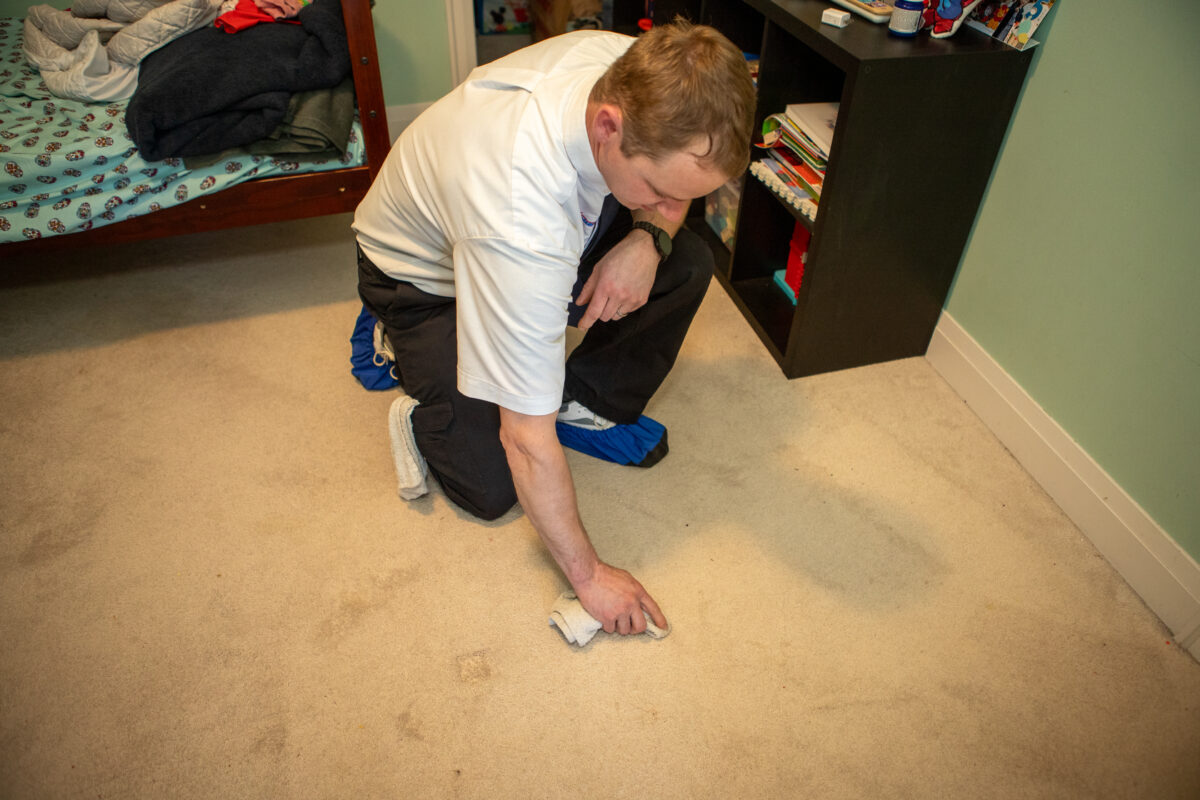
What Are the Best DIY Carpet Stain Removal Methods?
Quick Answer: The best DIY stain removal method depends on the type of carpet stain you’re treating. Use water flushes for simple spills, like coffee, tea, or beer, detergent for mud, and multi-step solutions for protein, oil, or dye-based stains like blood, lipstick and chocolate.
Every day spills like coffee, wine, or mud (think muddy snow boots) don’t have to become permanent eyesores. The key is knowing which carpet stain removal method works best for each type of mess.
Below, you’ll find the most effective cleaning methods for common household stains. With this information, you’ll be able to treat carpet and rug stains quickly – and know when it’s time to call Prestige Carpet Cleaning for extra help.
Please note: These carpet stain removal methods are for general guidance only. Use at your own risk, and always test stain solutions in a hidden area first. For delicate or expensive carpet, rugs, flooring or furniture, professional cleaning is always the safest and most effective option.
Cold Water (or Soda Water) Flush Method
- Blot with a clean white cloth, towel or paper towel.
- Flush with *cold* water or soda water.
- Blot until dry.
Use this carpet stain removal method to get rid of:
- Coffee stains
- Tea stains
- Cola/pop stains
Warm Water Flush Carpet Stain Removal Method
- Blot with a clean white cloth, towel or paper towel.
- Flush with warm water (or soda water for alcohol).
- Blot until dry.
Use this stain removal method to get rid of:
- Beer stains
- Alcoholic beverage stains
Detergent Solution Method
- Blot up/remove excess.
- Apply a detergent solution*.
- Blot gently.
- Rinse with clean water.
- Blot again until dry.
Use this carpet stain removal method to get rid of:
- Mud stains – for mud on carpet or rugs, first let it dry, then brush, scrape, or vacuum up the excess.
- Latex paint stains
*See Detergent Stain Removal Solution Recipe. (Coming Soon)
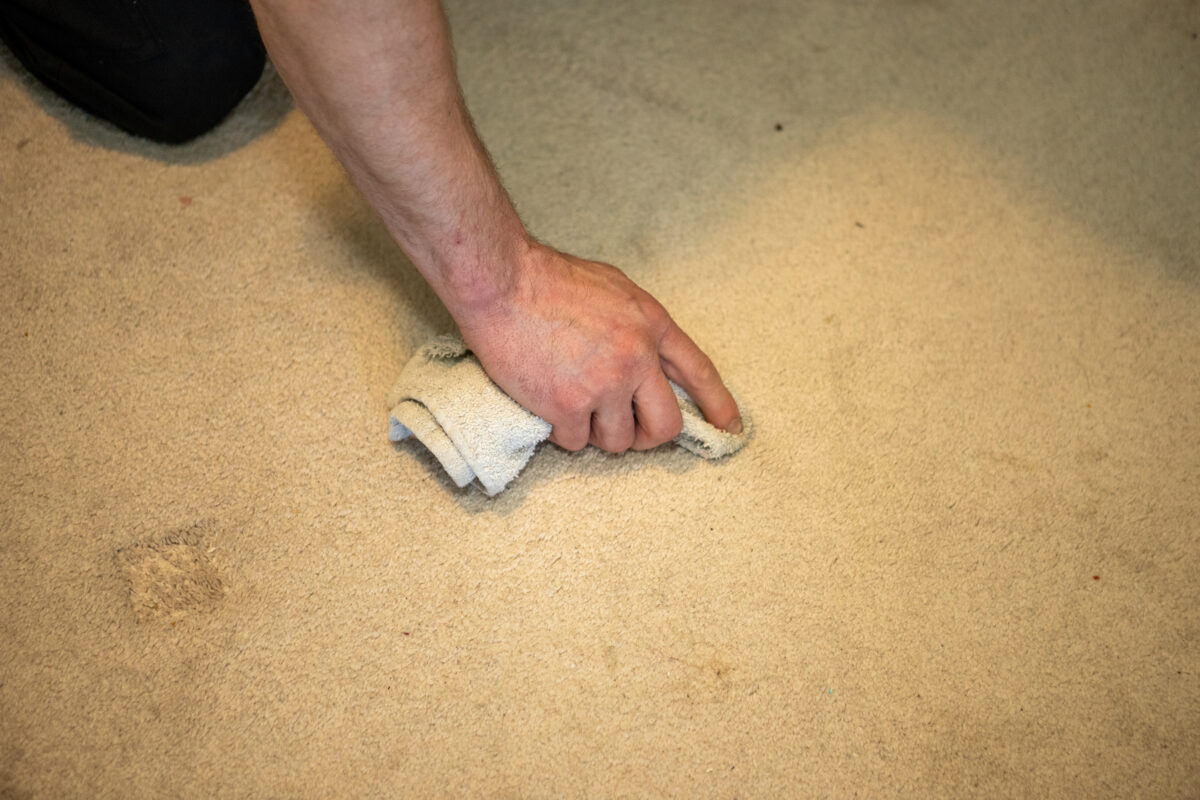
Detergent + Vinegar + Enzyme Method
- Apply detergent solution*, blot.
- Apply vinegar solution**, blot.
- Rinse and blot.
- Apply enzyme detergent solution***, blot.
- Rinse with clean water.
- Blot until dry.
This carpet stain treatment will get rid of:
- Blood stains – Always use cool water only. (Hot water can set proteins permanently.)
- Fruit juice stains
- Grass stains – Use cool water only, same as blood.
- Gravy stains – Gravy contains both protein and grease/oil, so it may require extra patience to remove this stain.
- Jello stains
- Ketchup stains
- Mustard stains
*See Detergent Solution Recipe. (Coming Soon)
**See Vinegar Solution Recipe. (Coming Soon)
***See Enzyme Detergent Solution Recipe. (Coming Soon)
Detergent + Ammonia + Vinegar Method
- Blot up excess (and remove solids, if necessary).
- Apply detergent solution*, blot.
- Apply ammonia solution**, blot.
- Apply vinegar solution***, blot.
- Rinse with clean water.
- Blot dry.
Use this carpet stain removal method to get rid of:
- Pet urine stains (dog or cat) – Odours may persist without professional cleaning and deodorizing.
- General animal stains
- Vomit stains – Clean up quickly to prevent odour.
- Red wine stains – Special pre-step: Dilute with a small amount of white wine first. Swap steps 3 and 4: With wine stains, apply the vinegar solution before the ammonia solution.
*See Detergent Solution Recipe. (Coming Soon)
**See Ammonia Solution Recipe. (Coming Soon)
***See Vinegar Solution Recipe. (Coming Soon)
Solvent + Detergent Carpet Stain Removal Method
- Remove excess/solids.
- Apply paint/oil/grease remover (solvent), blot.
- Repeat Step 1.
- Apply detergent solution*, blot.
- Rinse with clean water.
- Blot until dry.
Use this carpet stain removal method to remove:
- Wax stains
- Lipstick stains
- Crayon stains
*See Detergent Solution Recipe. (Coming Soon)
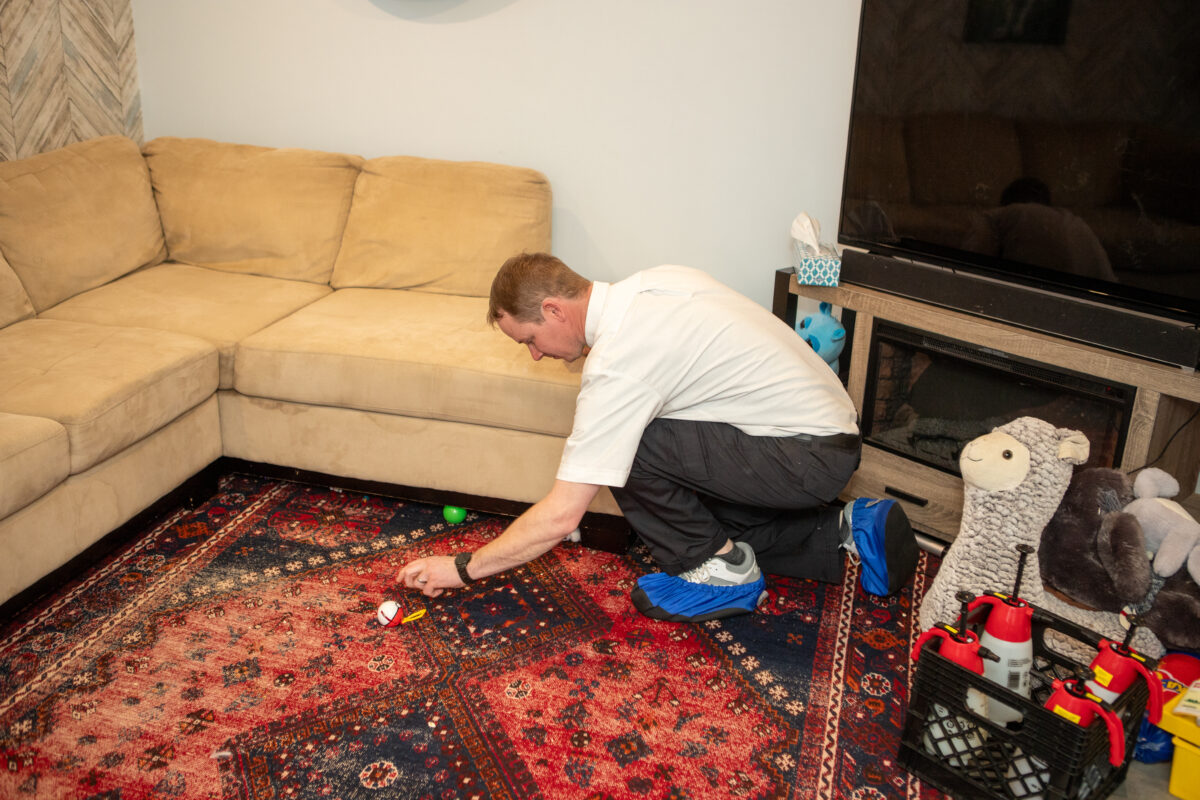
Non-Oily Nail Polish Remover + Solvent + Detergent + Ammonia Method
- Carefully blot up excess and remove any solids.
- Apply undiluted non-oily nail polish remover directly to the stain.
- Apply paint/oil/grease remover (solvent), blot. Repeat if necessary.
- Apply detergent solution*, blot.
- Apply ammonia solution**, blot.
- Rinse with clean water.
- Blot again until dry.
This carpet stain removal method will get rid of:
- Grease and oil stains
- Chocolate stains
*See Detergent Solution Recipe. (Coming Soon)
**See Ammonia Solution Recipe. (Coming Soon)
Solvent + Non-Oily Nail Polish Remover + Detergent + Ammonia + Vinegar Method
- Apply paint/oil/grease remover (solvent), blot.
- Apply non-oily nail polish remover, blot. If the stain remains, continue to the next steps.
- If needed, apply detergent solution*, blot.
- Apply ammonia solution**, blot.
- Apply vinegar solution**, blot.
- Rinse with clean water.
- Blot until dry.
Use this carpet cleaning method to remove:
- Nail polish stains – Very stubborn; may require professional rug or carpet cleaning.
- Oil-based paint stains
*See Detergent Solution Recipe. (Coming Soon)
**See Ammonia Solution Recipe. (Coming Soon)
***See Vinegar Solution Recipe. (Coming Soon)
Hair Spray + Solvent Method
- Spray with unscented hair spray. Let sit for a few seconds.
- Apply paint/oil/grease remover (solvent), blot.
- Repeat steps 1 and 2 if necessary.
- Rinse with clean water.
- Blot until dry.
Use this stain removal method to get rid of:
- Ballpoint ink stains – Act fast, as ink spreads easily.
For step-by-step directions on how to remove all types of carpet stains – from A to Z – use our Stain Removal Tool.
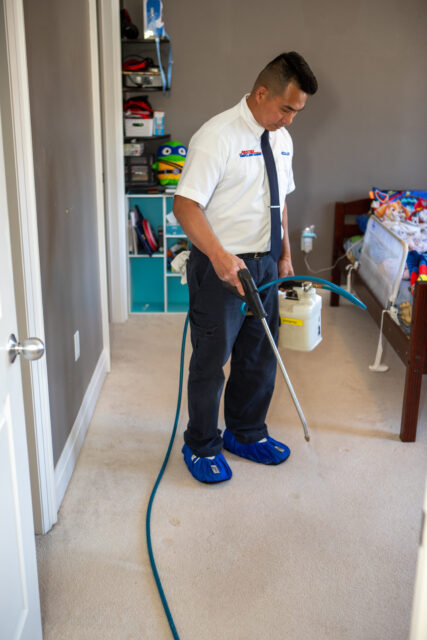
Should You Hire a Carpet Cleaner or Do It Yourself?
Quick Answer: Small, fresh stains can often be treated at home, but old, set-in, or protein-based stains and delicate rugs are best handled by a professional.
Whether you should hire a carpet cleaner or attempt to remove a stain using DIY methods depends on the type of stain, its size, how long it’s been there, and the material you’re working with.
Here’s what we recommend, depending on your situation.
When to DIY and When to Hire Professional Carpet Cleaners
| Your Stain Situation | DIY or Professional Carpet Cleaning? Prestige’s Recommendation | Explanation |
| Fresh stain | DIY stain removal | Fresh stains often haven’t had time to set, making them easier to remove with homemade or store-bought solutions. |
| Old or set-in carpet stains | Hire professional carpet cleaners | Old and set-in stains have dried and bonded with carpet fibres, making them much more difficult to remove without professional cleaning techniques, tools, and solutions. |
| Small, surface spills (e.g., a splash of coffee or juice) | DIY stain removal | Quick blotting and mild store-bought or homemade cleaners can usually remove fresh, surface-level stains. |
| Large or soaked-in spills | Hire professional carpet cleaners | Often, large spills penetrate deep into carpet padding and require professional extraction to prevent odours, bacteria, and the stain from returning. |
| Protein-based stains (e.g., blood, urine, vomit) | Hire professional carpet cleaners | Protein-based stains are tough to completely remove and often leave odours and bacteria. Therefore, they are best left to the pros. |
| Everyday stains (e.g., dirt or mud) | DIY removal | Everyday stains, like dirt or mud, are mostly surface-level and can usually be treated with DIY solutions. |
| Common food stains (e.g., juice, ketchup, or chocolate) | DIY stain removal | Most common food stains can be easily removed with the right DIY stain remover. |
| Recurring carpet stains | Hire professional carpet cleaners | If a stain keeps reappearing, it means residue is trapped in the carpet padding and requires professional deep cleaning. |
| Delicate or valuable carpets and rugs (e.g., wool, silk, Persian rugs) | Hire professional carpet cleaners | Most delicate or valuable carpets and rugs require specialized cleaning to prevent damage. *When in doubt, hiring a professional carpet cleaner is always the best and safest option. |
| Glue stains | Hire professional carpet cleaners | Glue stains are difficult to remove safely at home. Therefore, we recommend professional carpet cleaning. |
A good rule of thumb:
- If a stain is fresh, small, and water-soluble → try DIY.
- If a stain is old, large, set-in, protein-based, or keeps coming back → it’s time to call Prestige Carpet Cleaning.
Why Does Professional Carpet Cleaning Make a Difference?
Professional cleaners use industry-grade equipment and proven solutions that reach deep into carpet fibres. This allows them to remove stains and odours that store-bought and homemade DIY stain removers can’t.
For example, at Prestige Carpet Cleaning, our IICRC-trained professional cleaners use hot water extraction, enzyme treatments, and fibre-safe techniques to not only lift stains but to eliminate them at the source. That means no lingering odours, no hidden residue, and no damage to your carpet or rugs.
Professional carpet and rug cleaning also helps extend the life of carpets and rugs and creates a healthier home by removing trapped dirt, bacteria, and allergens.
In Canada, in particular, carpets face unique challenges throughout the year:
- Winter: Snow, slush, salt, and sand tracked in from boots can stain and damage fibres.
- Spring: Mud, moisture, and allergens are at their peak.
- Summer: Spills from BBQs, gatherings, and increased foot traffic can set quickly in the heat.
- Fall: Damp leaves and outdoor debris easily get trapped in carpets.
These seasonal factors mean Canadian carpets take more abuse than most, and DIY cleaning often isn’t enough to fully remove tough, year-round carpet stains, residues and odours.

Let Prestige Handle the Stains You Can’t
Some stains are just too tough for do-it-yourself solutions. Whether it’s pet accidents, red wine, or set-in dirt from a long Canadian winter, Prestige Carpet Cleaning has the expertise, tools, and solutions to remove messes safely. Best of all, our professional methods will protect your carpets, eliminate odours, and leave your home fresher and healthier.
Ready for spotless carpets? Book your professional carpet cleaning with Prestige today.
Rug & Carpet Stain Removal FAQs
Have questions about carpet or rug stains? You’re not alone. We’ve gathered answers to some of the most common stain removal questions to help you find the answers you need.
If you don’t see your question below, you can always reach out to Prestige Carpet Cleaning directly – or try our Stain Removal Tool for step-by-step guidance.
| Carpet Stain Removal Question | Answer from Prestige Carpet Cleaning |
Is professional carpet cleaning better than doing it yourself? |
Yes. Professional carpet cleaning is more effective than at-home DIY methods because professionals use industry-grade equipment and specialized solutions that reach deep into carpet fibres. As a result, they can remove hidden dirt, odours, and bacteria, extend carpet life, and prevent permanent damage. While DIY cleaning can help with some small, fresh stains, professional carpet cleaning is recommended for tough, deep-set stains, recurring stains, large stains, delicate or valuable carpets and rugs and glue spills. |
What do professional carpet cleaners use to remove stains? |
Professional carpet cleaners use hot water extraction systems, enzyme treatments, non-toxic professional-grade spot removers, and other fibre-safe cleaners to remove stains. These tools and solutions are stronger and safer than store-bought products, allowing professionals to remove stains at the source without harming your carpet. |
How to get old tough stains out of carpet? |
Old stains usually require professional cleaning because they’ve bonded with carpet fibres over time. The most effective way to get old tough stains out of carpet is hot water extraction, combined with professional-grade spot removers specifically designed for the type of stain being treated. DIY methods may lighten old stains but rarely remove them completely. |
Why are old carpet stains harder to remove? |
Old carpet stains are harder to remove because, as they dry, proteins, oils, and dyes chemically bond to carpet fibres. Some stains also penetrate the carpet padding or attract dirt, making them more noticeable. Heat, foot traffic, and time all “set” stains, which is why it’s important to act fast when a spill or accident occurs. |
Are there stains that cannot be removed from carpet? |
Yes. Some stains, such as bleach damage or old set-in dyes, can permanently alter carpet colour. In these cases, professional cleaning can minimize the appearance, but complete removal may not be possible. When that happens, repair or carpet replacement may be the only solution. |



